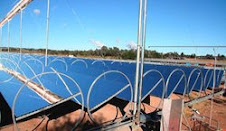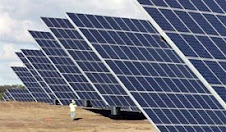China's Solar Industry riding on more than being the Low-Cost Player
by Jesse W. Pichel, Senior Research Analyst, Piper Jaffray
China is likely to be of paramount importance to the solar industry because of its low-cost manufacturing capabilities and potentially enormous domestic demand driven by new government programs. This was made abundantly clear in a recent visit to the country.
We hosted a solar panel discussion at the Piper Jaffray Internet and Technology Conference in Beijing, China, on March 3, and later met with senior management and toured five of the top six solar companies in China. We also met with wafer suppliers in Eastern Europe that supply Chinese solar cell OEMs.
We anticipate that many global solar OEMs are likely to pursue China strategies following the lead of Ersol Solar Energy AG (which appeared at the Piper Jaffray Solar conference in NYC on 2/21) with its JV investment in Shanghai Electric Solar Energy, Ltd. (a module supplier). Conversely, many of the Chinese solar OEMs may forward integrate by acquiring installers/ integrators in Europe and the U.S. Despite the blossoming low cost and integrated solar food chain in China, and several polysilicon feedstock plants that are under construction, there is no panacea to the current polysilicon shortage. Furthermore, we found little next-gen (thin film) technology other than a small 5 MW line in Tianjin.
How has our thesis changed? Our thesis remains that investors should focus on solar companies that offer the promise of lower cost per watt. To that end, solar companies operating in China will play an important role. However given that polysilicon, the major cost driver of solar today (raw poly is 40% of cost), is in short supply with rising prices, we prefer companies that possess technology that reduces (Evergreen Solar) or eliminates (Energy Conversion Devices) the need for polysilicon. Also we view polysilicon suppliers as lower risk solar investments (WFR).
Enormous solar capacity ramp under way in China: Chinese-based manufacturing will help lower the cost of solar. China has enormous (>1,000 MW) low-cost manufacturing capacity coming online over three years, and the entire solar food chain can now be found within China, including polysilicon feedstock, wafer, cell, and module production in addition to domestic wet-chemistry and equipment suppliers. In aggregate, the solar companies in China have focused on module capacity serving historically as an outsourced module- manufacturing partner. Module capacity of 450 MW will rise to 1200 MW by 2008. The 200 MW of domestic solar cell making capacity will rise to 1200 MW exiting 2008 with the ramp of three large cell makers and as certain wafer suppliers forward integrate. Wafer capacity of 100 MW in 2005 will grow to circa 800 MW by 2008 thanks to the production ramp of domestic polysilicon supply as well as large poly supply contracts beginning in 2008.
Chinese manufacturing cost advantages: In addition to labor costs that can be less than $200/month per worker, Chinese solar companies also benefit from lower SG&A (Sales, General and Administration or 'cost of doing business') Research & Development, peripheral costs, and tax rate. There is also an expanding solar manufacturing equipment industry that provides equipment at a fraction of the cost of equipment made overseas. The current generation of Chinese manufactured solar equipment includes module lamination, wafer etch/bath, and mono-crystalline wafer pullers (~$150,000 each). Also there is a growing list of lower cost wet-chemistry suppliers for slurry and aluminum paste. Chinese manufacturing lines tend to be more labor intensive and use more domestic equipment, requiring substantially lower capital expenditure. In particular, the Chinese module lines we toured do not run automated assembly equipment and instead favor an all-labor approach; the only equipment required are laminators and module testers.
No Chinese panacea to polysilicon shortage: Three Chinese polysilicon manufacturers dominate the domestic landscape. Sichuan Xinguang is still under construction with initial production in 2007, and 2008 planned capacity of 1,250 metric tons. LSCS now has capacity of ~300 ton, and plans 2007 capacity of 1,000 metric ton. ESM currently has annual polysilicon production of ~100 tons. Domestic poly production will not address near-term poly needs, as most production will not come online until 2008. Spot virgin poly prices are now as high as $200/kg, and many Chinese solar OEMs will happily pay $170/kg to secure poly. High-grade scrap (ingot tops and tails) command >$150/kg, while lower end scrap (pot scrap) can command $50-$70/kg. All solar companies are using a mix of scrap and virgin poly to keep their blended poly cost at ~$130/kg. Several Chinese solar companies, in anticipation of a future capital market transaction, have been stockpiling poly to the order of hundreds of metric tons. Additionally, we toured a major wafer reclaim facility that uses low-cost labor to sort and recycle broken/ rejected wafers from the semiconductor and solar industry.
Large domestic demand anticipated beginning in mid-2006: Solar demand in China is expected to increase significantly over the next several years driven by the Chinese renewable energy program enacted in February. Although the government has not communicated the details, the law is expected to generate 500 MW of annual capacity by 2010 ($3.5B USD), 3 GW by 2020, and 60 GW by 2050. Western China is an ideal location for solar given its 9 to 11 hours of sun per day (greatest in Tibet). Furthermore, many areas in Western China are off-grid and the government has an aggressive rural electrification initiative of ~300 MW. While details on the amount of subsidy have not been communicated, we learned of three large 30 MW solar power station projects planned for 2H06-2007. The prospect of large solar demand in China is likely to only benefit OEMs in China or global players with a manufacturing presence/JV in China. We believe that as funding for Chinese projects are finalized we may see more global OEMs partner or acquire suppliers in China.
Higher module prices and leading edge wafer thickness: Across industry, we find that spot module prices are now at $4.20 per watt. Contract prices remain circa $3.50 and below. In terms of wafer thickness, 240 um thickness is the norm in China and as a result, some manufacturers can now slice 45 wafers per kg of silicon (~100W at 10g/W), up from ~40 wafers (~88 W, 11.5 g/W) just six months ago -- a ~15% energy output improvement per kg. Although wafers can be sliced <100 um, thinner wafers are fragile and much more difficult to process into cells and modules.
About the author
Jesse W. Pichel, is Senior Research Analyst, Piper Jaffray & Co., a full-service brokerage firm based in Minneapolis, member NYSE and SIPC.
Buy hot new music from underground artist Yuya's new alternative cd, Give U Everything, at Rhapsody.com
MP3 Players, iPods, RingTones, digital music for sale online; New Rock and Reggae Music available for download:
Yuya's new album Give U Everything is now available to music fans worldwide; check out this new Canadian rock reggae recording artist at iTunes.com, MSN Music, Music.Yahoo.com, Rhapsody, emusic.com, StayAround.com, Musicload.de and more:
Find Yuya photos and songs at StayAround.com
Download Yuya CD Give U Everything at Music.MSN.com

Buy Yuya songs at Yahoo Music








No comments:
Post a Comment